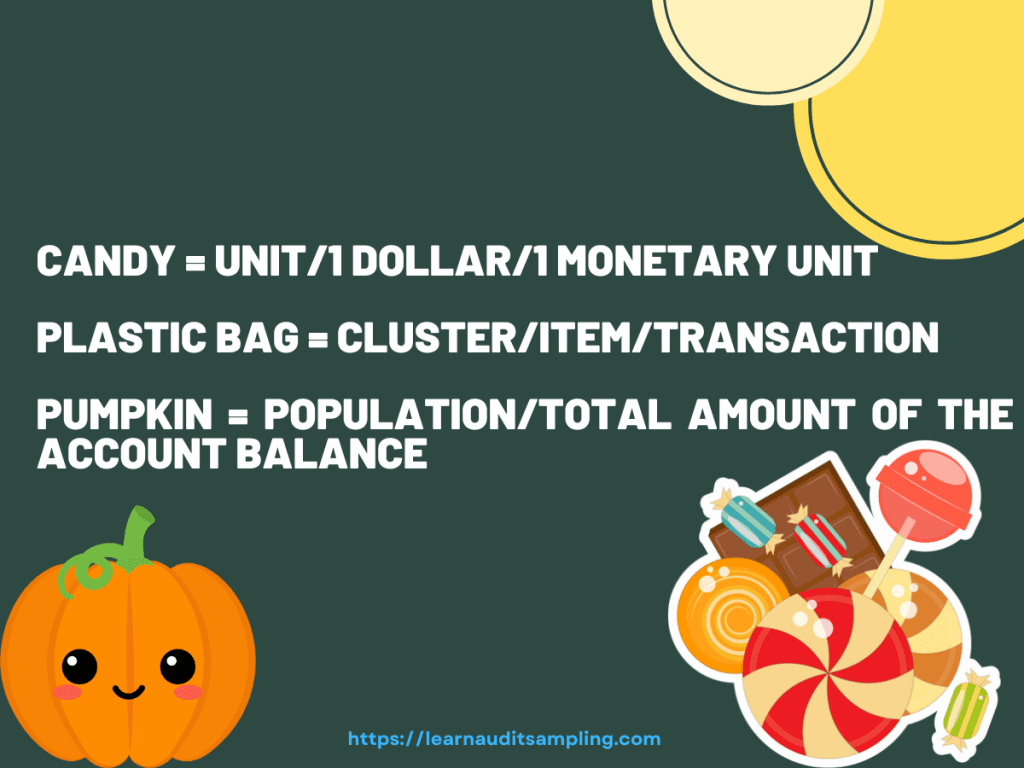
When learning something through academic sources, we often find the subject’s definition hard to grasp. A formal definition is always formal, counterintuitive, and hard to understand. We need several attempts, ask the teacher or friend, or reread tons of times before the definition becomes less vague or, better, becomes clear. After reading this blog post, you’ll better understand the definition of Monetary Unit Sampling (MUS); thus, you can follow along if it comes up in the conversation with your colleagues or professor.
A big promise. But no worries, we’ll use a very powerful tool: a story. Let’s dive in!
First, let’s gather MUS definitions from well-known sources.
MUS is a subset of a broader class of procedures sometimes referred to as probability proportional to size (PPS) sampling.
AICPA’s Audit Guide: Audit Sampling
A variation of systematic sample selection by unit of interest is used by the probability-proportionate-to-size (PPS) sampling methods. Here, the individual dollar is considered the unit of interest. The interval is determined based upon a statistical formula, and the transactions associated with that dollar interval are selected. MUS uses PPS for its sample selection method.
Arens, Alvin A., et al. Auditing: the art and science of assurance engagements
MUS sampling defines the sampling unit as each individual dollar making up the book value of the population. A transaction or account is selected for audit if a dollar from that transaction or account is selected from the population. Therefore, each transaction or account has a probability proportional to its size of being selected for inclusion in the sample.
Whittington, Ray, and Kurt Pany. Principles of auditing and other assurance services
Those MUS definitions mention probability proportional to size (PPS). What’s PPS, you might think? This PPS stuff is a statistical sampling method, a method to pick samples from the population. Below is an explanation on the Wikipedia page, which I found easier to understand.
One of the cases this occurs in, as developed by Hanson and Hurwitz in 1943, is when we have several clusters of units, each with a different (known upfront) number of units, then each cluster can be selected with a probability that is proportional to the number of units inside it.
Cochran, W. G. Sampling Techniques
Isn’t it clearer? If not yet, how about reading a story to help picture the concept in our minds?
Imagine you want to throw the most epic Halloween party ever for the kids in your neighborhood. You have a brilliant idea that will make everyone scream with delight. You’ll carve a huge pumpkin and stuff it with all kinds of yummy treats. The kids will have a blast digging into the pumpkin and taking home as much candy as possible. It will be a Halloween to remember!
You want to ensure every kid gets a fair share of the candy loot. So you devise a clever trick: bundle up some candies in plastic bags and fill the pumpkin with them. That way, each kid can grab a bag and get a bunch of treats in one go. No one will leave empty-handed or disappointed.
You want to add some variety to the candy stash. So, you mix and match different treats and pack them in plastic bags of different sizes. Some bags are big and bulky, some are small and sleek. The kids will have fun guessing what’s inside each bag and choosing their favorite ones.

The Halloween party is a blast. The kids are eager to get their hands on the candy-filled pumpkin. Some kids can’t get enough sweet treats and linger around the pumpkin. Others are so excited they jump on the pumpkin before it’s their turn. It’s a crazy and fun scene.

Now, back to our PPS stuff. First, let me introduce some synonyms.

Then, we go back to the formal PPS definition.
We have several clusters of units. Yes, we do, each plastic bag is a cluster of candies.
Each (cluster) has a different (known upfront) number of units. Sure, every plastic bag holds a different number of treats. We know how many candies are on each piece of plastic, and we can (if needed) put the number on the bag.
Each cluster can be selected with a probability proportional to the number of units inside it. The kid can select each plastic bag. And by its nature, the kid tends to grab a bigger bag because it’s more rewarding for the kid. And a bigger bag is more eye-catching and easier to pick. Thus, each plastic bag’s probability (being picked by the kid) is proportional to the number of candies inside (to size).
I hope now you have a better understanding of the PPS definition. It’s time to convert it to our Monetary Unit Sampling definition.
The total account balance amount in MUS is the population or the pumpkin in our Halloween party. Each dollar (or other monetary unit) is a sampling unit. However, a financial transaction or item (such as inventory or asset) rarely has a dollar value. Oftentimes (at least in my experience), a transaction has more than one dollar value. Ergo, a transaction is similar to a plastic bag, each has a different value or size (although some transactions can have the same value).
When we have a pumpkin filled with tons of plastic bags or an account balance with transactions, whatever sampling selection we used, whether using a kid’s hands, a scoop, or any common statistical method, we will more likely to pick a bigger bag of candy than a smaller one. As an auditor, a bigger transaction is more interesting because it has a bigger risk. So, the method (PPS/MUS) satisfies us because it tends to pick the bigger transaction (or plastic bag or cluster, if you will).
Based on this understanding, we know there’s no need to revisit the rusty old book from our statistics class to know that a transaction with a $10 value has a tenfold probability (of being picked) than a transaction with a $1 value.
This aligns with Whittington’s Monetary Unit Sampling definition, “each transaction or account has a probability proportional to its size of being selected for inclusion in the sample.”
Probability proportional to size (PPS) is a sampling method that treats a cluster’s chance of being picked as a sample proportional to its size. A cluster’s size depends on how many units exist in it. Monetary unit sampling is a specific application of PPS within the context of auditing financial statements.
Though MUS has a slightly different definition, as AICPA’s Audit Guide: Audit Sampling pointed out, MUS is used to describe the sample size and evaluation methods. Or, simply, MUS is a complete method to perform substantive tests because it contains how to calculate the sample size, pick the sample, and then project the misstatement.
You have just learned about the monetary unit sampling definition through a story. We hope you enjoyed reading this blog post and found it helpful. You now know what monetary unit sampling is from the sample selection perspective. You also know that oftentimes, people refer to MUS as a complete toolkit.
You can comment below if you have another story(ies) that helps you understand the concept. Or maybe you want to join our newsletter to get more content from this blog, fill out the form below, and let’s embark on this audit adventure together!
Dall-E3 generated all images.